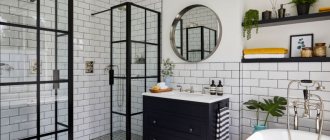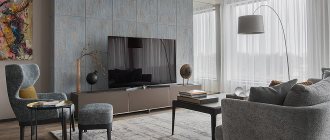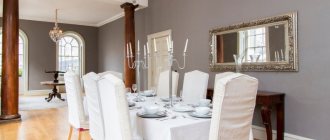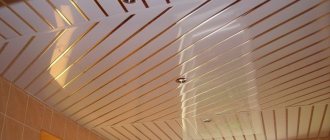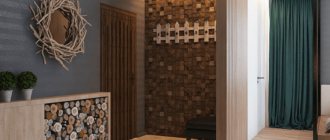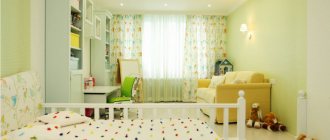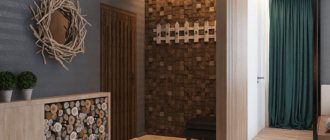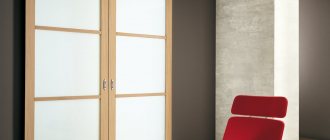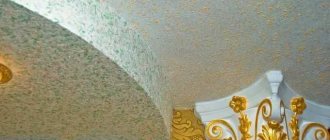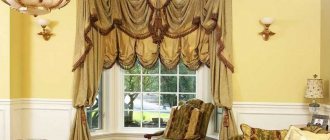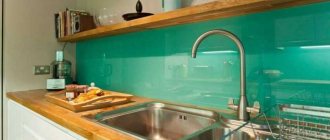Advantages of wallpapering the ceiling
Wallpapering the ceiling is often the most affordable and budget-friendly way to decorate a living space. The undeniable advantages of this material for ceiling surfaces include:
- ease of operation;
- no need for careful leveling of the surface;
- wide choice of texture and color of ceiling wallpaper;
- high speed of finishing work.
Using thick textured wallpaper will hide minor unevenness in the base, so you won’t need to perfectly level the ceiling.
You can choose the material to suit any style and color scheme of the room. It is not difficult to complete the job in one day, even without prior experience of such work.
Repairing a ceiling with wallpaper will not require the purchase of special equipment and tools. The use of wallpaper suitable for painting will facilitate subsequent renovation of the room.
The disadvantages of ceiling wallpaper include a limited service life, as well as the unsuitability of this finishing option for rooms with high humidity. In the bathroom and kitchen, ordinary paper wallpaper quickly begins to peel off and peel.
Features of vinyl wallpaper
Vinyl wallpaper is available on paper or non-woven backing. Moreover, each of them has its own characteristics, but they all have common characteristics.
- making seams requires special care, since wallpaper can stretch when pasted and shrink after drying;
- have a dense structure, are treated with a protective layer, are often produced with a washing effect and are moisture resistant, which allows gluing in damp rooms;
- Due to vapor permeability, it is not recommended to cover bedrooms and children's rooms with vinyl.
Watch how to properly glue vinyl wallpaper end-to-end in the following video:
Features of choosing ceiling wallpaper
A competent approach to carrying out repair work involves studying the technical features of the varieties of ceiling wallpaper. Photos of wallpaper on the ceiling will give you a clear idea of how different textures look. When choosing, be sure to take into account the overall design style of the room, as well as the color scheme of the room.
Experts recommend choosing a glossy texture and light-colored wallpaper for the ceiling for rooms with limited space. This will help visually enlarge the room. Thick wallpaper with a deep relief pattern will help hide small flaws in the ceiling surface.
When choosing, it is useful to read the information from the manufacturer located on the label of each roll. It contains the characteristics of the material, its composition, as well as recommendations for working with the material.
- It is necessary to calculate the amount of material in order to immediately purchase wallpaper from one batch. The calculations must include a small margin for adjusting the pattern.
- Paper wallpaper is appropriate for a living room, nursery or bedroom. For the kitchen, hallway, bathroom or bathroom, it is recommended to choose moisture-resistant wallpaper.
- The width of the wallpaper for the ceiling is important. It should be understood that it is more convenient to stick a standard canvas with a width of 50 or 55 cm.
- When choosing glue, it is important to take into account the manufacturer’s recommendations. For each type of finishing material, it is necessary to use a specially designed adhesive composition.
Wide choice of wallpaper types for the ceiling
Meanwhile, there are enough of them to get lost in this diversity.
Paper wallpaper
This is the most common, inexpensive, but not the most durable option. If the goal is not a “forever” renovation, then they can be perfect for finishing a room, since they will look clean and fresh for about 5 years. The most common variants are domestic ones, predominantly white in color, smooth or embossed texture.
Several negative aspects should be highlighted.
- They have minor difficulties when gluing - you will have to smear them with glue, which somewhat complicates the process.
- They are not resistant to moisture and other external influences, so they are best suited for the hallway, living room, and children's room.
- They provide only a dry cleaning method, but at the same time they significantly absorb dust and other contaminants.
But purchasing paper wallpaper for the ceiling also has a number of advantages - the minimum price compared to any other materials and the environmental friendliness of the composition, since it contains cellulose and there are no harmful impurities.
Textile wallpaper
This type of decorative coating is an excellent solution for finishing the ceiling. The advantages of using it are quite significant. Due to its texture, the joints of the canvases are almost invisible. Increased heat and sound insulation properties. The presence of these advantages does not mean a complete absence of disadvantages. The rough texture, which in one case is a plus, can also bring a number of problems associated with care. Wallpaper of this type is especially prone to dirt and the accumulation of odors and dust.
Liquid wallpaper
They have practically no drawbacks and are ideal for working with uneven ceilings and hard-to-reach places, as they fill the entire surface. They have an environmentally friendly composition, which sometimes includes silk and gold fibers to give a special structure. Helps isolate noise and retain heat. But some difficulties cannot be avoided with them. A special method of application to the ceiling may not be so much a problem as it will require some effort and the use of special equipment. They have a fairly high sensitivity to moisture, so they are not suitable for all rooms and types of cleaning.
Glass wallpaper
Fiberglass wallpaper is a good option for covering a ceiling for painting. They differ from others in a number of qualities unique to them. They contain only natural substances: clay, quartz sand and some other natural ingredients. They not only have excellent resistance to various environmental influences, such as dust or sunlight, but even fire. They are particularly durable, which is reflected in the appearance of the ceiling and have a significant variety of patterns and are excellent for painting. With this finishing method, no defects will be visible.
The only drawback in this case is the price, but it is also low, given their long service life.
Vinyl wallpapers
Vinyl wallpaper can have either a non-woven or paper base. Their difference lies in the top foam layer of polyvinyl chloride. It is this that allows you to create a special interior with the help of a variety of patterns and embossings. In addition, wallpaper of this type is very resistant to external damage, has increased strength and is able to level less than ideal surfaces. To clean them, you can use any means, including liquid ones. You can also change the color of this ceiling wallpaper before painting, and not glue it every time you change the interior.
Non-woven wallpaper
Non-woven wallpaper for the ceiling is the most popular when choosing the finishing of this part of the room. And there are a serious number of reasons for this. Thanks to the non-woven base, you can avoid various difficulties with pasting. Since in order for the wallpaper to stick tightly to the ceiling, you need to apply a layer of glue only to the place where it will be located, and not to the canvas itself. This will allow you to move the roll in the desired direction without any problems. This type of wallpaper will also help to hide all the shortcomings of the ceiling tiles, without significant preparation. In addition, they will last a long time, and also do not contain toxic substances and are quite resistant to external influences. Excellent for painting.
In order to change the color of the ceiling, no complicated steps are required. They can be easily removed if they require replacement, leaving a durable, even layer of non-woven fabric. They do not require complex, painstaking preparation of the ceiling covering, since they not only fit perfectly on an uneven surface, but are even capable of masking significant defects. On the construction market you can find many options for this type of wallpaper:
- colored, including plain and multi-colored;
- for painting;
- smooth;
- with various reliefs from geometry to floral patterns.
To decide which wallpaper will look best on the ceiling, photos of already finished rooms will be of great help.
Calculation of wallpaper consumption on the ceiling
When calculating material consumption, it is necessary to carefully measure the length and width of the room. It is not difficult to correctly calculate how many rolls of wallpaper will be needed for the ceiling, knowing the area of the room and the parameters of the roll (length and width).
To determine the number of rolls you need:
- divide the width of the room by the width of the wallpaper;
- Divide the length of the room by the length of the roll.
You should add a margin for adjusting the pattern and some unevenness of the ceiling surface.
Correct gluing technology
Before starting work, you must close the windows to avoid drafts. This must be remembered, since high-quality finishing will not work if this condition is neglected!
Before gluing wallpaper for the ceiling, you need to perform a number of procedures. Level the surface of the ceiling, clean it of old material. Then they do the following:
- It is recommended to fix the canvas relative to the window, moving towards the door. By doing this, you will be able to make the joints invisible. Glue materials perpendicular to the window. If there are no windows, the rolls are fixed along the length of the ceiling. The markings are made parallel to the walls - they pull the string and apply strokes.
- The material is cut into sheets of the required length. They leave a reserve. Then you need to understand how the canvases will be glued - from the middle of the ceiling, or from the wall. It is convenient to apply a marking line to the surface. Then a sheet of material is glued. The glue is applied to the ceiling with a roller.
- Glue is prepared differently for different types of wallpaper. If the material is heavy, a thick mixture is needed - it will securely fix it to the ceiling. Dilute the glue strictly according to the instructions.
- It doesn’t matter whether original embossed wallpaper or glass wallpaper is used, the adhesive is applied in strips that are wider than the material. The best option is to add 5 cm to the size of the canvas. Places that are difficult to handle with a roller - corners, joints are passed with a brush.
Pasting goes like this: the wallpaper is applied to the ceiling treated with glue. Then they pass it with a spatula. It is important to monitor the alignment of the pattern on the canvases. Excess glue between the glued pieces is removed with a dry cloth. Then a spatula is used along the seam.
Craftsmen advise that after pasting and painting the material, make sure that the sun's rays do not fall on them. It is better to cover the windows with newspapers. When the canvases dry, their service life will be long.
- Ceiling wallpaper: DIY gluing
The technology of finishing such as gluing ceiling...To watch photos "
How to wallpaper a ceiling
The work of decorating the ceiling is labor-intensive, but does not require special experience or special tools. A competent approach involves dividing it into several stages.
Preparatory stage
It is important to create optimal working conditions:
- dismantle lighting fixtures;
- empty the room of furniture;
- take care of wire insulation;
- close windows to avoid drafts.
An important question is what comes first: the ceiling or the wallpaper on the walls. In the case of wallpapering the ceiling, it is easier to start from the ceiling. Otherwise, there is a high probability of staining the new wallpaper on the walls, raising the stripes to the ceiling.
- The usual practice is to cover the ceiling first, and then the walls, bringing the wallpaper under the ceiling.
- It is more difficult to decide what comes first, wallpaper or suspended ceiling. When gluing walls yourself, it is better to complete the work before installing the suspended ceiling sheet.
- As part of the preparation, you should get rid of the old coating, clean the surface with a spatula, and plaster over cracks and irregularities. It is recommended to treat the ceiling with a primer to make it easier to glue the wallpaper.
Cutting the canvas
- Before gluing wallpaper on the ceiling, be sure to cut the prepared rolls.
- The strips are placed along the walls at right angles to the window opening. With this gluing scheme, the seams will become less noticeable in natural light.
- The length of the walls is carefully measured, the strips are cut with the pattern adjusted and a small allowance.
DIY wallpapering on the ceiling
The adhesive composition is prepared in strict accordance with the instructions. The finished glue is carefully distributed over the surface of the wallpaper using a brush or roller. Particular attention is paid to the edges.
- After applying the adhesive, it is reasonable to wait 10-15 minutes. The glue will saturate the strip of wallpaper.
- At this time, the adhesive composition is applied to the ceiling surface at the location of the wallpaper strip.
- The strip is applied to the ceiling on one side. Pressing, gently smooth with a rubber spatula or a clean roller from the center to the edges. This will remove air bubbles from under the canvas.
- The remaining strips are glued in exactly the same way.
- At the place where the chandelier is attached, a cut is made crosswise.
- After completing the work, the ceiling should dry. You can’t open the windows, a draft will ruin all the work.
It's easy to do the gluing with two people. If you don’t have an assistant, then it makes sense to use non-woven wallpaper; it’s easier to glue them.
What wallpaper can be glued to the ceiling?
In Russia, some manufacturers produce ceiling wallpaper specifically designed for ceilings. This is a high-density paper material, white with a relief pattern (another name is embossed). But many types of wall wallpaper are also suitable for the ceiling.
Paper
Consist of one or two layers. The first option is very thin and fragile, and is not suitable for ceilings. Most often the surface is smooth, but sometimes shallow embossing is done.
Paper wallpaper is the most budget option. They are environmentally friendly and allow the surface to “breathe”, so the microclimate will be favorable for health. The material is light and will not peel off under its own weight.
But this type of wallpaper is short-lived - it lasts no longer than 5 years and does not tolerate dampness well. You should not stick it in the kitchen, bathroom or hallway.
Difficulty in gluing is also noted. Unlike other types, you need to coat both the ceiling and the wallpaper. The paper gets wet, tears and stretches easily, and after drying it can shrink. Due to the small thickness, unevenness will be noticeable. The problems are more pronounced with single-layer material.
Wallpaper for painting
The base is paper or non-woven, sometimes with vinyl coating. The material itself is white or a similar color; the surface can be painted several times, and, if desired, even covered with original designs. They are mainly produced with different types of textures, but sometimes they are also smooth.
The main advantage of this type is the ability to quickly change color using dyeing. But if the wallpaper is located on the ceiling, the weight of the coating and the condensation that forms due to it is added to the total mass. As a result, the wallpaper falls off faster.
Vinyl
The base is made of paper or non-woven fabric, and foamed PVC is applied on top. The result is a relief coating that is resistant to moisture and can even be washed with a sponge. Vinyl wallpaper with non-woven backing is suitable for the kitchen or bathroom because it does not dampen and is easy to clean.
The texture masks minor surface imperfections well. You can’t level the ceiling as carefully as you would with thin paper wallpaper.
Non-woven
The base is non-woven cellulose material with synthetic additives. The wallpaper is strong and durable and can be cleaned with a soft brush or damp cloth. It is easy to stick - only the ceiling is applied, and the coating is pressed dry. They do not shrink and to some extent hide unevenness and cracks. They allow steam to pass through, providing a healthy microclimate.
The rolls are wider than the paper variety. Wallpaper sticks faster, and there are fewer joints, so the ceiling looks more aesthetically pleasing. But each cut turns out to be heavier, which is why it can peel off faster.
Textile
It is a luxurious and sophisticated material created using fabric. Such wallpaper is quite durable and dense, and partially retains sound and heat. They allow air to pass through, but do not tolerate moisture well. Dry cleaning only is suitable for them. Even the glue is selected specially. Another significant drawback is the high price.
Natural
The basis of such wallpaper is paper or non-woven fabric. Various natural materials are glued on top, for example, bamboo leaves or quartz sand. The design emphasizes exclusivity and handcraft.
This surface looks beautiful and unusual, but is not easy to maintain. Some options are heavy and not suitable for ceilings. And the main disadvantage is the high price (they cost several times more than ordinary paper and non-woven wallpaper).
Fiberglass and cobwebs
These materials are similar in origin and properties. They are made from natural compressed fibers, based on quartz sand with the addition of dolomite, soda and lime. The fiberglass coating is durable and dense, resistant to mechanical damage and not afraid of water, and therefore durable (lasts up to 20 years).
Fiberglass wallpaper hides ceiling imperfections (cracks and gouges) better than other types, and even has reinforcing properties. The material does not burn and does not emit toxic substances when heated, hypoallergenic and environmentally friendly. The surface does not collect dirt and dust and can be washed with any chemicals, including the most aggressive ones.
The material is suitable even for hospitals and children's institutions.
Fiberglass or “gossamer” has a flat surface, while wallpaper is more decorative, covered with patterns and reliefs. Both varieties are painted many times, but this is more difficult than with other materials, and the composition consumption increases.
The main disadvantage is the high price. The weight is also considerable, so the “web” will hold up worse than most other options.
Liquid wallpaper
The material is sold dry, diluted with water and applied like plaster. The composition includes cellulose fibers, cotton, silk and various decorative additives. Sometimes the mixture is sold already colored, in other cases a colorant is added to taste.
The result is a surface reminiscent of ordinary wallpaper, but without joints. The design is very diverse thanks to a wide range of colors and various additives (for example, glitter or mineral particles). With some skills, you can create patterns and designs by combining different batches.
Silk plaster fits without problems on ceilings of non-linear design (with protrusions, niches or arches). Easily hides minor imperfections in the flooring. For minor damage, just wet it a little and smooth it out. The material absorbs sound and keeps the house warm.
The main disadvantage is instability to moisture. But the minus is compensated by covering the surface with varnish (matte or glossy). True, in this case it will be more difficult to carry out minor repairs. Another disadvantage is the high cost compared to analogues.
Photo wallpaper
The image is printed on a paper or non-woven base (sometimes coated with vinyl). The size is quite large, so the drawing is divided into parts. Format - like wallpaper rolls or other sizes.
This option can increase the space in the room. But they note some inconveniences associated with the choice. Firstly, most of the drawings are created for walls, and therefore do not always look good on the ceiling. Secondly, the size may not coincide with the length and width of the overlap. Then the free spaces will have to be covered with another roll or painted over. Other features depend on the choice of base material.
